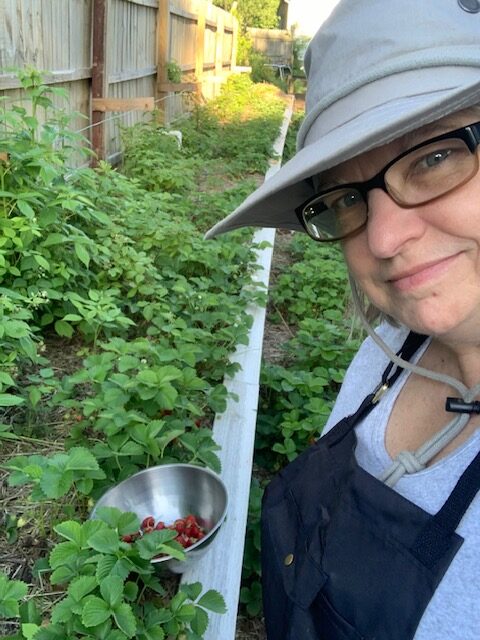You invest long before the return.
How many gardeners have jumped into growing fruits, herbs and other perennial edibles and realized too late that this would require work and–more importantly–time before you yield results? We all had bean plants in elementary school that seemed to grow overnight. That experience whet the appetites of many of us future gardeners, because we had proof that it worked! But what our teachers didn’t show us is how plants can have a wide variety of needs and growing timelines. Yes, we can take a seed out of an apple or another plant and grow it, but reality is more complicated and by far more an exercise in delayed gratification.
Some years ago my husband, Jeff, spotted a strawberry pyramid planter on Pinterest and decided on the fly to build one himself. Anyone who knows him knows that once Jeff’s decided on a project, he is not easily swayed to put it on hold to investigate fully. He is a jump-in-the-cold-water, head-first and keep swimming kind of guy. I’m the opposite. I’ll research the details and analyze it from all angles before I get started doing anything, and many times I’ll quit after weighing the pros and cons. He started his pyramid project while I was on a summer vacation visiting family, and it was sitting in the driveway, half-completed when I returned.
“It’s a strawberry planter. All you have to do is plant them in it and we’ll have fresh berries!”
Jeff Dempsey
“See what I’m building for you?” he grinned proudly. “It’s a strawberry planter. All you have to do is plant them in it and we’ll have fresh berries!” I was both excited and anxious. I knew it wouldn’t be that simple, but I had seen the posts myself. A pyramid of full, thriving greenery with luscious, heavy red berries seemed possible. “Where will we put it?” I asked. It couldn’t stay in the shaded driveway. It needed full sun and water. Jeff pointed out the spot right outside our basement walkout door. It had full sun and was right in front of the water spigot. I ordered 50 bare-root plants from an online nursery in our region, to be delivered in a couple weeks.
A week later, Jeff prepared to move the completed behemoth into place. While building it in the shade was a good idea to avoid working in the hot summer sun, doing so required moving the heavy structure. It’s a good thing he owns some heavy equipment, as it took his track hoe and heavy chains to lift it in one piece and move it the 50 feet to its new home. Once it was set, we needed to fill it with dirt. “Before we do that, should we add irrigation?” I asked. Jeff is an irrigation contractor, after all. I thought he’d certainly have the materials to do this right. So he rigged it with pvc, hose and spray heads.
It needed a LOT of dirt to fill it. We decided to fill the lower half with large rocks we had and save the good soil for the outsides and upper portion. But the dirt we used from our property was heavy with clay. We did add some compost to it, but I now know it was nowhere near enough. I packed some looser soil into the levels, and we were ready to plant.
The plants arrived soon after. I dutifully tucked them in throughout the planter and watered them. We continued to water them in the following days, watching some of the plants die in the heat while others grew voraciously. A few weeks later we saw a few flowers. This was exciting. We knew that flowers turned into berries, so with visions of shortcakes dripping with berries and whipped cream in our minds we left them to grow. A couple months later we did harvest a few small bowls of strawberries. Success!
In the fall, we had to resolve how to protect the plants from the cold. We’d have to cover them with straw, but how could we keep it in place? I devised a “cage” molded around the structure using chicken wire, and we stuffed straw into it a few inches thick, covering all the plants. That worked to an extent, but when we uncovered it the following spring we had lost about half the plants. After that, the plants seemed to languish, and we weren’t able to keep up with it. Eventually we scrapped the pyramid, although we did move a few plants to a bed next to the house. They grew for several years there, but they never really produced more than a handful of berries.
Fast forward to late winter, 2020. We had acquired the lot next door to us, and Jeff used the retaining walls and terraces to create two levels of four-foot-wide planting beds. He told me to plan on trying strawberries again. He has a vision of creating our own hobby berry farm, including all kinds of berries. The strawberries are just a small part of his grand design. (I’ll tell you more about that later.)

This time, when filling the beds, we brought in better soil, mixed it with sand and compost to give the berries a good, organic base. The bottom bed would be all strawberries while the top would have raspberries along the fence, with strawberries at their feet, along the front edge. The two 50-foot-long beds are approximately two feet in height difference, giving us a shelf or bench of sorts to help us access the plants easier. He had installed the irrigation system basics ahead of time.
This time, I knew we should order at least two varieties that would help pollinate each other and afford us both a large harvest in early summer and berries throughout the season. I chose Tristar, Sequoia and Ozark Beauty plants, some June-bearing and some everbearing types. This time around I’d had the time to research how to properly prepare and care for these new plants. I purchased a good, organic berry fertilizer to have on hand before the berries arrived. A couple weeks later–it was early spring–more than 200 bare root plants arrived at our door in the middle of my work week. That day, I rushed home, tore the package open and put them in buckets of water. One of Jeff’s friends, Rich, arrived to help me plant them. Jeff was working past dark those days to turn on his clients’ sprinkler systems. Rich and I dug holes, added a little fertilizer, a layer of dirt, then spread out the roots of each plant and covered them, tamping each down with our hands around the crown that we kept just above the soil. We watered them in by sections, working well into the dark using headlamps to complete the planting.

We finished the last few after dark.
In the subsequent days, we continued to keep them watered. Luckily, we didn’t get a late freeze that affected the new plants. This time around, I followed conventional wisdom and pinched off all the flowers to eliminate a first harvest, thereby giving the plants more time to establish themselves before devoting energy to producing fruit. We religiously weeded and watered, weeded and watered. Jeff finished setting up the soakers and spray heads that helped us give them enough water without moving sprinklers or manually watering with hoses. Later that summer, I did allow a few flowers on the everbearing plants to produce fruit. (I can delay gratification only so long!) We had enough berries to make a few batches of strawberry shortcake. The everbearing plants continued to give us fruit through the mild fall, even into November!
Once winter had finally arrived and the plants started to wilt (late December), we covered all the beds with about four to six inches of straw. We had learned that covering them too early would cause them to rot, but it was important to give them a good bed of insulation.

This spring, once it started getting warmer, I pulled off some of the straw but left the piles just to the side, just in case the weather turned backward. Sure enough, it did. I found myself raking the straw back over the plants in time before a hard freeze. A few days later, I carefully uncovered them again. But Mother Nature wasn’t done messing with me. In May, a full three weeks after our normal last frost date in central Missouri, a hard freeze was again predicted. That could be dangerous to plants that were already flowering. I had ordered some non-woven row cover fabric from a farm supplier, and we spread it over the plants before that cold night. It worked, and the plants didn’t suffer any damage, even when the temperatures dipped to 28 degrees.
Just a few short weeks later, I was harvesting my first full-season strawberries. It’s now early June, and I’ve been picking every other evening since, pulling more than six or seven quarts of berries each time. I now know that allowing the plants the time to establish themselves was important, as was the proper soil, fertilizer and consistent watering as well as winter protection. Our investment has yielded more ruby-red, beautiful fruit than we can consume.

For now, I’ll just enjoy these little red beauties while waiting for the next berries in the garden to ripen. I’ll be hulling and slicing berries while watching TV in my evenings, handing out quart bags of sweet vine-ripened berries to friends and searching for more recipes .
Watch this space for new recipes and ideas for canning or preserving the harvest soon!



